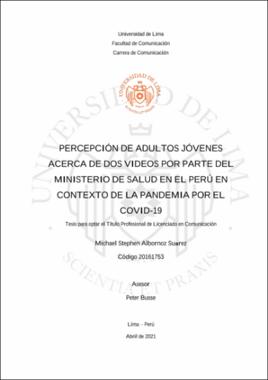| dc.contributor.advisor | Busse Cárdenas, Peter | |
| dc.contributor.author | Albornoz Suarez, Michael Stephen | |
| dc.date.accessioned | 2021-09-11T02:00:24Z | |
| dc.date.available | 2021-09-11T02:00:24Z | |
| dc.date.issued | 2021 | |
| dc.identifier.citation | Albornoz Suarez, M. S. (2021) Percepción de adultos jóvenes acerca de dos videos por parte del Ministerio de Salud en el Perú en contexto de la pandemia por el Covid-19 [Tesis para optar el Título Profesional de Licenciado en Comunicación, Universidad de Lima]. Repositorio Institucional de la Universidad de Lima. https://hdl.handle.net/20.500.12724/14028 | es_PE |
| dc.identifier.uri | https://hdl.handle.net/20.500.12724/14028 | |
| dc.description.abstract | El sistema de salud peruano ha tenido desafíos en las últimas décadas con la llegada de diversas enfermedades infectocontagiosas. La etapa de prevención es fundamental para evitar futuros colapsos en postas, hospitales y clínicas. Los mensajes comunicaciones son herramientas para que la población pueda conocer en cómo evitar enfermedades y compartir esta información a mayores personas. Con la llegada del COVID-19 en marzo del 2020, se creó una incertidumbre sobre las medidas necesarias para evitar la alta propagación de contagio. Es por ello que el gobierno peruano aplicó herramientas comunicacionales para reducir la curva de contagios y ocupación de camas de unidad de cuidados intensivos. Sin embargo, debió tomar una decisión en la naturaleza de estos mensajes: si apelar al lado emotivo o explicar la situación del país con cifras.Se realizó una prueba previa a la investigación para validar el grupo focal con el objetivo de estudiar las percepciones que tienen adultos jóvenes sobre dos videos comunicacionales realizados por el Ministerio de Salud en contexto del COVID-19. La intención fue la de descubrir si existe un cambio de comportamiento y lamento anticipado cuando se exponen dos videos: uno que apela a lo emotivo y otro a la razón con cifras. Los resultados mostraron que las personas tienden a identificarse con el video emotivo debido a que despierta en ellos experiencias vividas en contexto del COVID-19. Además, intensifica su responsabilidad de evitar contagiarse para no afectar a adultos mayores con quienes tienen frecuente contacto. Ante el video numérico, los participantes mostraron distancia y cuestionaron la validez de las cifras mostradas y que genera más cuestionamientos que resolución de dudas sobre el uso de recursos hospitalarios. Se puede concluir que las personas tienden a cambiar sus actitudes y pensamientos cuando la naturaleza del material audiovisual es emotiva y se pueden identificar con personajes de la narrativa propuesta. | es_PE |
| dc.description.abstract | The Peruvian health system had challenges in recent decades with the arrival of various infectious diseases. The primary prevention is essential to avoid future collapses in medical outposts, hospitals and clinics. Communicational messages are tools for the population to learn how to avoid diseases and share this information with other people. With the arrival of COVID-19 in March 2020, an uncertainty was created about the necessary measures to avoid the high spread of infection. That is why the Peruvian government applied communication tools to reduce the curve of infections and use of intensive care unit beds. However, they had to make a decision on the nature of these messages: whether to appeal to the emotional side or to explain the situation in the country with numbers. An investigation was carried out with a focus group with a previous test for its validity, in order to study the perceptions that young adults have on two communicational videos made by the Ministry of Health in the context of COVID-19. The intention was to discover if there is a change in behavior and anticipated regret when two videos are exposed: one appealing to the emotional and the other to reason with numbers. The results showed that people tend to identify with the emotional video because it awakens experiences lived in the context of COVID-19. Furthermore, it intensifies their responsibility to avoid being infected so as not to affect elders with whom they have frequent contact. Instead, for the numerical video the participants showed distance and questioned the validity of the numbers shown and generates more questions about the use of hospital resources. It can be concluded that people tend to change their attitudes and thoughts when the nature of the audiovisual material is emotional and they can be identified with characters in the proposed narrative. | en_EN |
| dc.format | application/pdf | |
| dc.language.iso | spa | |
| dc.publisher | Universidad de Lima | |
| dc.rights | info:eu-repo/semantics/openAccess | * |
| dc.rights.uri | https://creativecommons.org/licenses/by-nc-sa/4.0/ | * |
| dc.source | Repositorio Institucional - Ulima | es_PE |
| dc.source | Universidad de Lima | es_PE |
| dc.subject | Comunicación en medicina | |
| dc.subject | Pandemias | |
| dc.subject | Health promotion | |
| dc.subject | Communication in medicine | |
| dc.subject | Pandemics | |
| dc.subject | COVID-19 | |
| dc.subject | Perú | |
| dc.subject | Promoción de la salud | es_PE |
| dc.title | Percepción de adultos jóvenes acerca de dos videos por parte del Ministerio de Salud en el Perú en contexto de la pandemia por el Covid-19 | es_PE |
| dc.type | info:eu-repo/semantics/bachelorThesis | |
| thesis.degree.level | Título Profesional | es_PE |
| thesis.degree.discipline | Comunicación | es_PE |
| thesis.degree.grantor | Universidad de Lima. Facultad de Comunicación. | es_PE |
| dc.publisher.country | PE | |
| dc.type.other | Tesis | |
| thesis.degree.name | Licenciado en Comunicación | es_PE |
| renati.advisor.orcid | https://orcid.org/0000-0002-5570-1299 | |
| renati.discipline | 322026 | |
| renati.author.dni | 70654501 | |
| renati.level | https://purl.org/pe-repo/renati/level#tituloProfesional | * |
| renati.advisor.dni | 09858074 | |
| renati.juror | Roeder Carbo, Estela | |
| renati.juror | Chávez Guerrero, Josue | |
| renati.juror | Busse-Cárdenas, Peter | |
| renati.type | https://purl.org/pe-repo/renati/type#tesis | * |
| dc.subject.ocde | https://purl.org/pe-repo/ocde/ford#5.08.00 | |
| ulima.cat | OI | |



